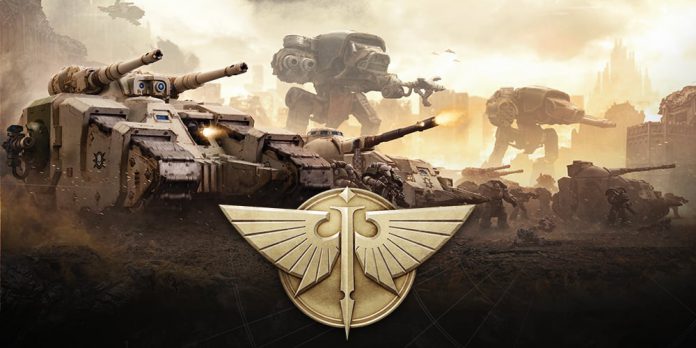Many thanks to Games Workshop for sending us an advanced copy of Legions Imperialis for review. Veterans of the Long War and miniature mini fans rejoice, the spiritual successor to Epic, Legions Imperialis is here. In this article we review the system from the perspective of someone who hasn’t played the earlier games.
Legions Imperialis is fought at a different scale to most Games Workshop models, with a range of models that are ¼ the scale* of their full-sized counterparts in Horus Heresy. This scale allows the game to simulate significantly larger battles and engagements, while taking considerably less time and space.
*If you want to start a fight on several community groups, ask innocently if the models are in 6 or 8mm and walk away.
What is Legions Imperialis?
Legions Imperials is the spiritual successor to Epic 40,000 (or, more precisely, Space Marine: 2nd Edition from the early ‘90s), Games Workshop’s 6mm mass-battle system from days gone by. It’s a game of massive armies made up of tiny tanks, where the battles you’re used to from 40k and Heresy are merely set dressing to the grand strategy and even grander destruction taking place around them.
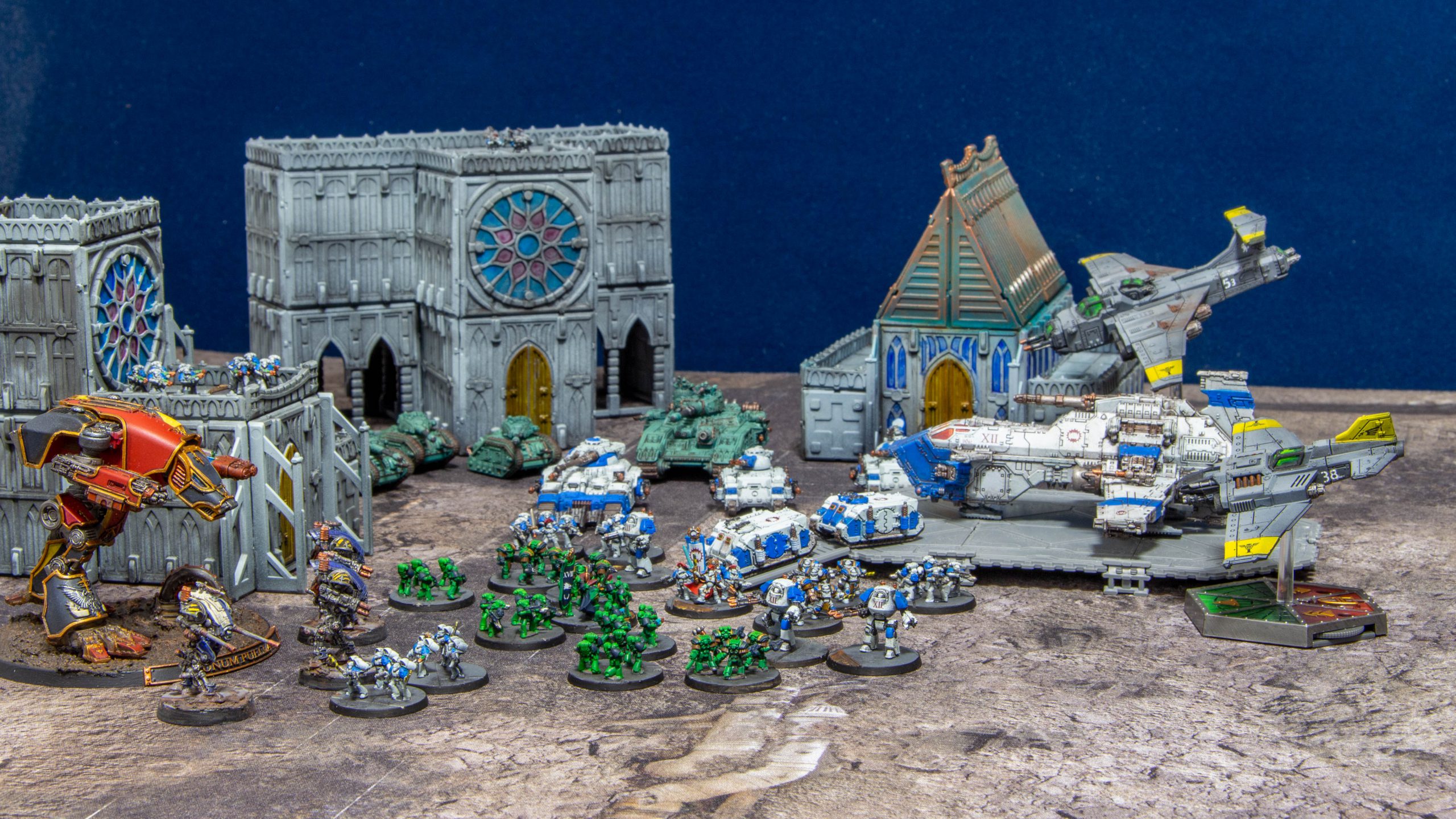
Each player fields a force drawn from the Legiones Astartes or the Solar Auxilia, then vies for dominance over a massive battlefield while garrisoning buildings, calling in close air support, and drowning enemy positions in lasfire and artillery. It’s a game where Titans walk the earth alongside armor formations, and both get shot to hell by a Thunderhawk on a strafing run.
But it’s equally important to talk about what Legions Imperialis is not. It is not set in the 41st millennium, instead being set in the Horus Heresy. While the decision to set the game in the Heresy had us initially somewhat confused, it later moved to outright baffling with the announcement that not only would xenos armies not be included at release, but there were absolutely no plans to include them in the game at all. Games Workshop then doubled down on this position by removing Eldar, T’au, and other xenos from Aeronautica Imperialis, presumably on the grounds that, moving forward, AI would only include models that were compatible with Legions Imperialis.
So out of the gate, this game may not be for you. It turns out that there are a lot of players out there who want to play xenos armies, and will refuse to play a game that doesn’t include them. Just ask the Warlord Wednesdays crew: the most common reason offered when someone would decline an offer to Play Titanicus–not to buy in, but to play a learning game with models provided free-of-charge for the duration–was simply that they had no interest in playing a game without Aeldari, or T’au, or Necrons, or whatever army they played that doesn’t show up in the Heresy.
Basically, unless you’re OK with playing a Heresy Legiones Astartes army, or are one of the roughly two-dozen people on the planet who really get excited about Solar Auxilia, you probably won’t care much about Legions Imperialis. But if you are in one of those categories, this game is likely laser targeted at you, personally, and you should probably check to make sure GW hasn’t gone ahead and preordered it for you.
Preparing for War
Much like other games by Games Workshop, several game formats are available – the one you are most likely to play will be based on the Matched Play rules, which we’ll discuss in a bit. The game is played over five turns, with a shared primary objective that revolves around progressive scoring of objectives on the table and personal secondary objectives which are scored at the end of the game.
Thankfully, scoring that primary objective isn’t just as simple as “put some plastic on it.” Various units have a “Tactical Strength” determined by their unit type: Titans have a Tactical Strength of 0, while Infantry come with a mighty 5. This means that objectives are best controlled by infantry bases with their boots on the ground rather than tanks, and that the towering God-Engines of the Mechanicum can’t interact with objectives at all – meaning that you shouldn’t just spam armoured companies over a combined arms force.
To actually build that force, you’ll start by picking a main faction between one of the Legions involved in the Heresy or Solar Auxilia forces. Next, you’ll choose a Formation from one of the ones on offer for your faction. Similar to how detachments worked in 9th edition 40k, each Formation requires you to take a certain number of compulsory units of specific force organization types, then allows you to take more optional units of certain specific roles. As an added bonus, some of them give you a neat bonus rule that helps make the Formation unique. As just one example, the Legion Demi-Company formation for Space Marines improves the Tactical Strength of non-infantry units when they’re on the same objective as friendly infantry, making it that much easier to lock down objectives even if your opponent is contesting them.
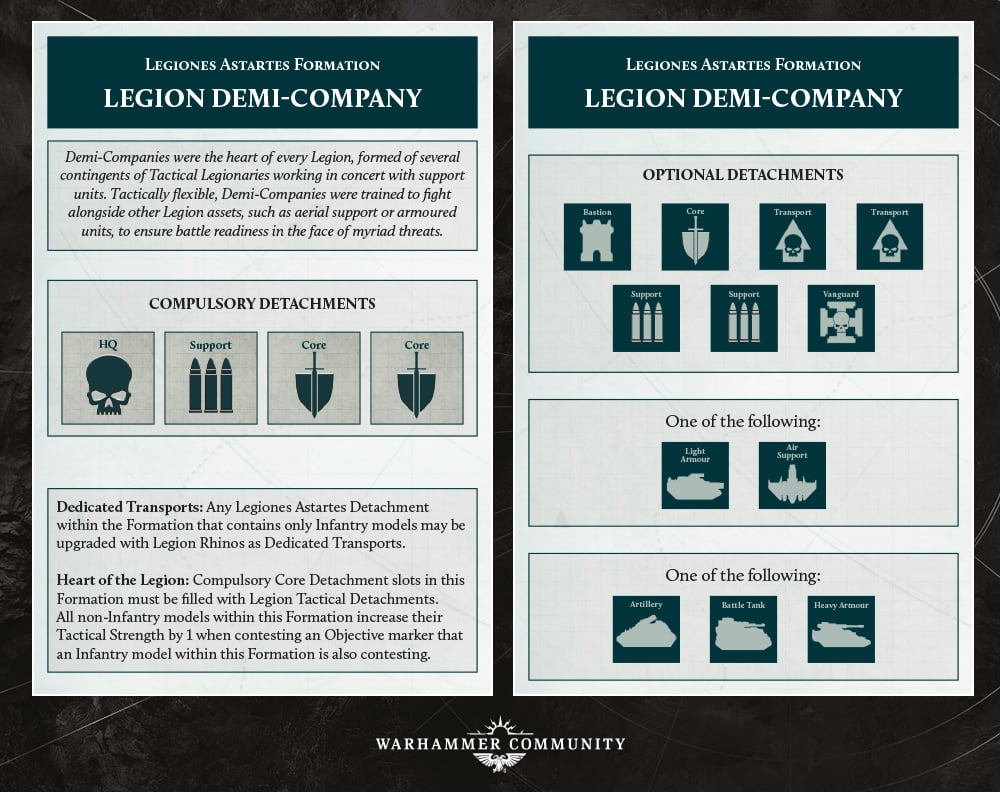
You’re required to take at least one formation, but you’ll almost certainly find yourself taking more: not only is it all but impossible to cram 3,000 points into a single formation, the limitations on how many units of a particular role you can take–particularly when it comes to Flyers–will mean you’re going to be sorely tempted to take a larger number of formations to get access to as many of the units you really want to take as possible.
This strategy isn’t without downsides, though: first, only 30% of your force can be made up of formations from a faction that isn’t your main faction. Thankfully, this restriction only cares about the “super-faction,” so if you’re the sort of weirdo who wants to bring a “Shattered Legions” force comprising elements from various legions in one army, those all count as Legiones Astartes for purposes of determining what your main faction is. But that means that, in a 3,000 point game, you get 900 points to spend on Titans, Knights, and units from the army you didn’t start with.
Additionally, once you start playing the game, you’re going to have to keep a careful eye on which formation a given model is at all times: once half of the models in a given formation have been destroyed, it becomes “Broken.” Once a formation is Broken, the detachments in that formation can no longer take any order other than Advance or Charge orders, and any time they take a Morale check, they do so at a -1 penalty. This isn’t the most terrible thing that you’ll ever experience, as you’ll likely find that Advance and Charge are the two orders you’re most likely to issue, especially later in the game when you probably don’t need the extra movement from March to get where you’re going.
The real penalty here is the bookkeeping: you have to know which formation every model in your army is in at all times, and you’ll be constantly checking to make sure that those formations aren’t below their break point. You can get around this to an extent by taking fewer formations with larger forces, but that will severely limit the availability of several of the most impactful units you have available to you. Instead, you’ll probably find yourself building lists that look more like the ones in the White Dwarf preview game, each of which had more formations than they strictly needed.
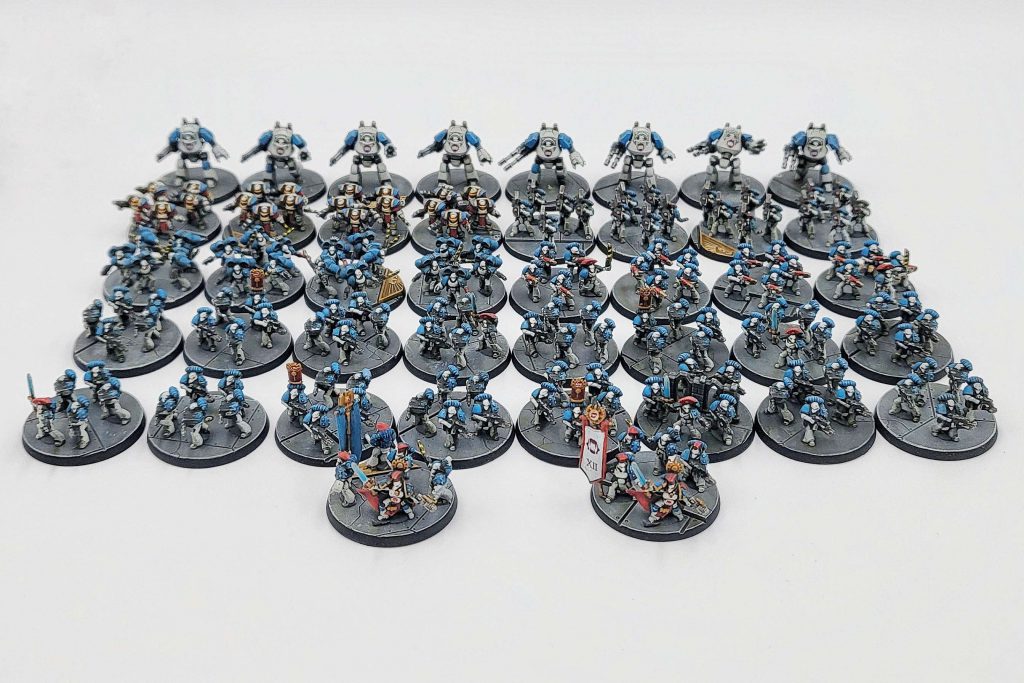
Mustering your Army
Each faction has a solid selection of units available to them, with each offering some easily-recognizable favorites together with some less-popular choices that may find a new lease on life here. The Legiones Astartes offer somewhat tougher infantry units together with fast-moving armor, the unparalleled flexibility of Contemptor Dreadnoughts, and overwhelming air superiority in the form of the Xiphon Interceptor. Add in a flying Turbo-Laser Destructor strapped to Thunderhawk, a slow but reliable shooting platform in the Deredeo Dreadnought, and a wide variety of Legion Rules that let you customize the force of your dreams, and there’s a lot to be said for the Angels of Death.
On the other hand, the Solar Auxilia really revolve around their armor: the Leman Russ may be a bit slower than a Predator, but it’s tough as nails and can mount what is likely one of the most devastating weapons in the game point-for-point in the Vanquisher battle cannon. Its heavier cousin, the Malcador, packs a main gun that’s just as destructive alongside a bonus demolisher cannon and an extra wound besides. Their infantry isn’t particularly durable, but their specialist units in the Velatarii Storm Section and Charonite Ogryns are very strong: they’re slow, and a bit expensive, but they will absolutely destroy anything they come into contact with.

Finally, if you’ve got a Titan Legion you built for Adeptus Titanicus, you’ve got the opportunity to get a few of them off the shelf. Knights and Titans all have multiple wounds, something of a rarity in this game, and Titans come with Void Shields, which function as ablative wounds that have a 50/50 shot of regenerating each turn, lending them surprising durability. And while these engines are all expensive–Knights run anywhere from 180 for a Questoris up to 250 for an Acastus, while Titans range from 330 for a Warhound to 750 for a Warmaster or Iconoclast–their datasheets are well worth the expense. Even the Rapid-Fire Battlecannon, which is in the running for “Least Impressive Knight Weapon,” packs the same firepower as a pair of Leman Russes, and things only get more destructive from there. Titans have easy access to laser blasters and turbo-laser destructors, both of which are incredible weapons, and the Warlord’s Belicosa volcano cannon comes with a staggering AP-5, which ignores almost any armor save in the game. We say “almost,” because the 750-point Warmaster Iconoclast complement their impressive 7 wounds and 12 void shields with the absurdity that is a 1+ armor save, rendering weapons without at least AP-1 completely useless against them, and offering a 1-in-6 chance of shrugging off the single most powerful weapon in the game.
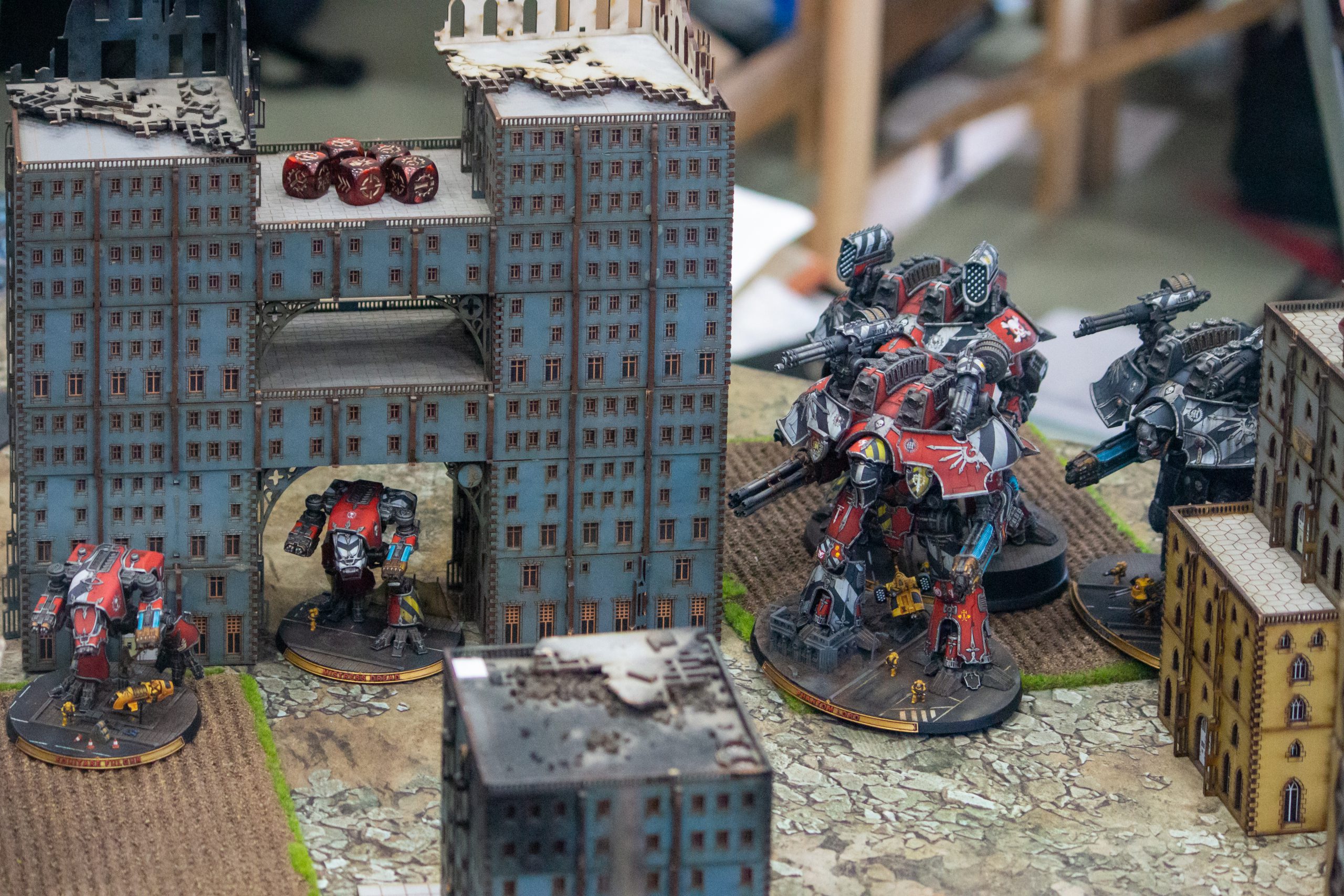
The Starter Set
The starter box comes jam-packed with miniatures, offering a nice selection of units across both main ranges, plus a pair of Warhound Titans you can slot into your forces as you deem fit. Each side comes with roughly 500 points of models–about 507 for the marines, and 594 for the Solar Aux, depending on how you field them. Add a 330-point Warhound to each side, and you’re somewhere around 900 points per side out of the box.
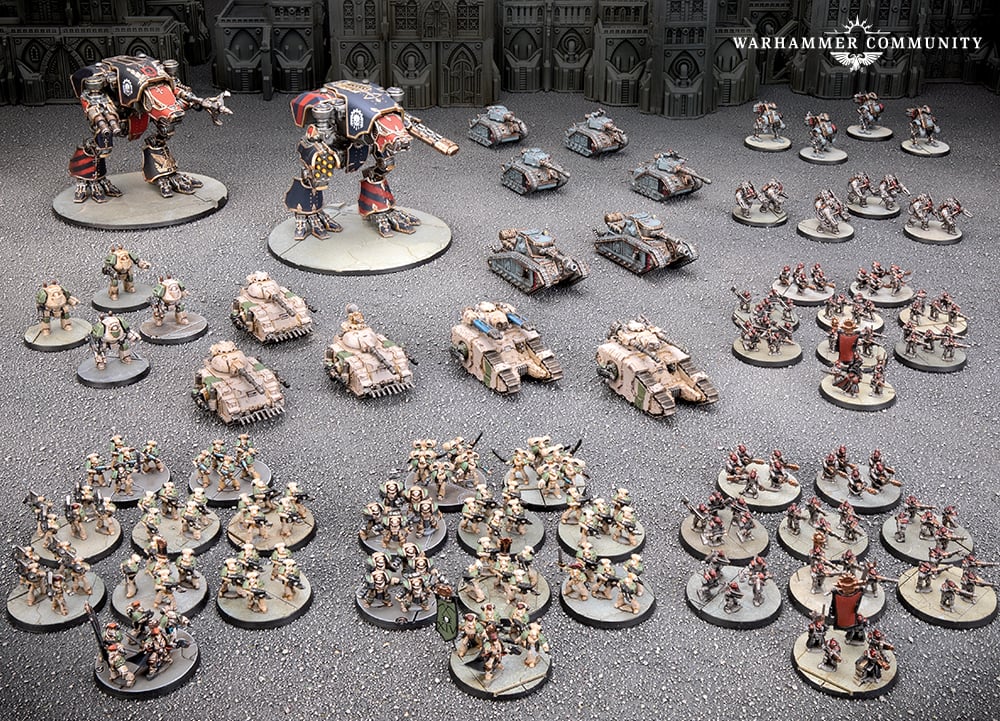
That said, even that 900 points is a far cry from the recommended game size of 3000 points. Put another way, if you and a friend each bought a starter set and each took the models for the faction you wanted together with a pair of Warhounds each, you’re still only about one-third of the way to playing the game as recommended by the designers.
Of course, once you’ve got your 900 or so points of plastic arrayed on the table, you might start to think that a full game of 3,000 points is a bit excessive. We’re inclined to agree, and would recommend that you start by aiming for a more manageable force of 1,500 to 2,000 points. Not only will this help you get used to the system without getting bogged down by too many activations, we suspect that 6,000 points in total on the table may start to feel a bit cramped, especially on a dense table.
Rules Oddities
As cool as these forces are, there’s a lot of weird edge cases and odd rules that don’t seem to work exactly the way you’d hope. As one example, take the comparison between a detachment of Assault Marines and a Solar Aux Velatarii Storm Section. Even on the charge, the Assault Marines are likely to get destroyed in close combat, since the Storm Section’s power axes come with the Rend special rule, adding another d6 to their combat roll.
Even weirder is the implementation of Ion Shields for Knights: they’re a separate save that is modified by half of the incoming attack’s AP, so an ion save only takes a -1 penalty once you get to AP-2, and that penalty goes to -2 at AP-4 or higher. But since most Knights are Sv 2+ with Ion Shields (4+), those shields don’t actually kick in and do anything until faced with an attack of AP-3, at which point the Knight gets a 5+ save. And don’t even get us started on the Acastus, which gets no benefit from its Ion Shields unless it’s shot by a Belicosa.
Lastly, if you’re coming to this game from Adeptus Titanicus, steel yourself, because there’s some weird shit going on when Titan-on-Titan violence begins. All weapons from a detachment resolve simultaneously, but the order of allocation is selected by the player who controls the target, which means that if your Warlord with a Belicosa, gatling blasters, and a power claw fires everything into my Warhound, I get to choose what order to resolve those hits in. So I can just take the Belicosa on the voids, then hope I can shrug the lower AP from the gatlings on my armor. It’s weird, and very counterintuitive if you’re coming to this game from Titanicus.

Each of the various Space Marine Legions have their own Legion trait, which gives them their own unique feel. Disappointingly though, some of them are clearly more useful that others. As just one example here, the World Eaters’ Incarnate Violence trait makes their melee far more reliable than any other legion’s . While game balance and flavour are often diametrically opposed, and this game is more aimed at the narrative and hobbyist segment, don’t be surprised if you see disproportionate amounts of some legions at events.
Special Rules and Weapon Traits
Legions Imperialis makes extensive use of universal special rules to cover the wide cast of units and a broad array of weapons fielded in the Horus Heresy. It’s so extensive, in fact, that roughly 20 pages of the rulebook are devoted to weapon traits and special rules. Getting your head around these can be a bit daunting at first, although you’ll learn the most commonly used traits soon enough.
Just keep in mind that some traits don’t do exactly what you think they do at first glance, such as Assault being what 40k players will recognize as Rapid Fire (double shots within half range) or Rapid Fire being what this game’s version of Sustained Fire (unmodified 6s to hit generate extra hits).
This is also true of some of the weapon traits at first glance: having the Anti-Tank trait doesn’t improve your output into tanks, but will instead make you worse at shooting anything else. On the flipside, a weapon with the Light AT trait is versatile, but worse at firing into tanks. You’ll eventually find that weapons with none of these traits are king. This may seem a bit odd at first, but will make sense once you’ve played the game.
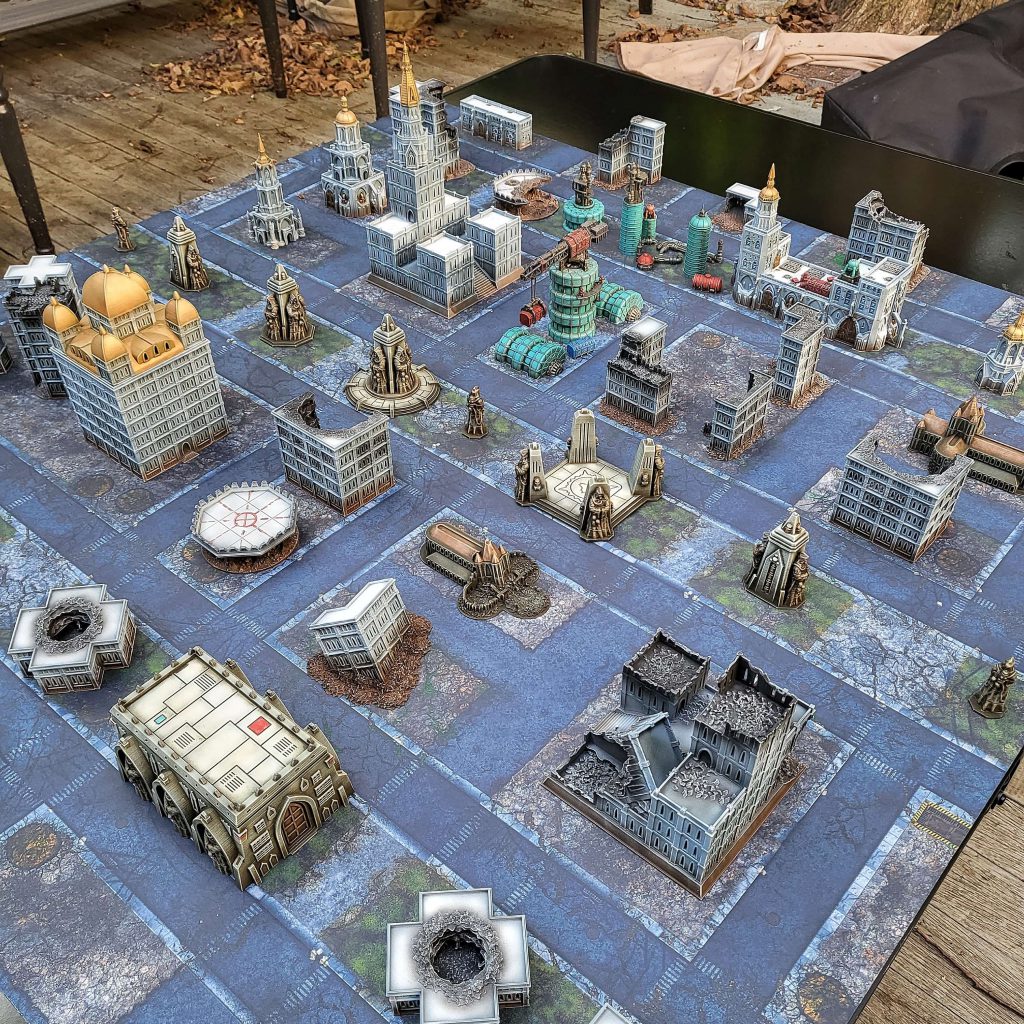
Terrain and Cover
Just like many other systems, having the correct amount of terrain is absolutely vital to ensure a balanced game while setting the stage for your battlefield. Not only do you want some decent line of sight blockers, but you will also want a good mix of terrain that gives partial cover as well as structures for your infantry to garrison in. Large line-of-sight blockers are great, but you’ll also want a decent number of smaller buildings and scatter terrain to give your forces plenty of places to take cover without necessarily shutting down line-of-sight outright.
We foresee this being one of the biggest hurdles for many people, as being in a different scale will require considerable effort to purchase/create and prepare suitable terrain in this scale. Even Adeptus Titanicus players will need to broaden their collections to include many smaller structures and area terrain which may not have been prioritized. This system is definitely what the Citivas Imperalis terrain kits were designed for, and if you had accidentally made structures that wound up being too small for Adeptus Titanicus, never fear: it turns out you were making terrain for Legions Imperialis all along.
The Missions
The missions are are a highlight of this ruleset. The use of progressive scoring of primary objectives encourages you to leave your deployment zone and contest the field quickly, giving use to more mobile and less deadly units. The tactical strength mechanic rewards the use of combined arms and goes a long way to set the scene for your games. The often asymmetric secondary missions keep things fresh and offer you end-game scoring for accomplishing tasks other than simple objective control. The combination of these angles work well and are considerably more interesting than trying to table your opponent.
There are also a solid number of missions on offer, with varied deployment maps and plenty of different arrangements for objectives. As an added bonus, many of the missions include rules that make objectives outside your deployment zone worth more points, giving you plenty of incentive to get out there and actually play the game.
Finally, this system adds an interesting little wrinkle to objective control: while Tactical Strength may seem similar at first glance to the Objective Control stat in 40k, in Legions Imperialis control is not a simple binary. Many of the missions only allow you to score points for “uncontested” objectives, which means you have to have double your opponent’s Tactical Strength within range of the objective to score. This makes infantry and other smaller units much more powerful in the objective game, since even if they don’t have enough bases to take the objective from you outright, they may at least be able to stop you from scoring it.
How it Plays
Each turn is split into a number of phases, beginning with the orders phase where you decide what each detachment of your force will do this turn. This is done by both players at the same time in secret by use of tokens, meaning you have to plan ahead and anticipate what your opponent is up to.
The orders are:
- First Fire: Which allows a unit to fire before others at the cost of not moving. This isn’t as powerful as it is in Adeptus Titanicus, as all units that are eligible to move do so beforehand – meaning that they can dodge you accordingly as they know you won’t be moving.
- Advance: The default order, allowing you to move and fire a detachment. If you forget to put a marker down, you get this order instead, leaving you with options. It’s also the objective you’ll find yourself issuing the most, as it comes with the most flexibility.
- March: Forgo your combat activation in exchange for legging detachments across the table. This is double for normal units or triple for infantry who aren’t in a transport. Most infantry units move 5”, while vehicles move around 10” – so this is a significant boost.
- Watch out for those assault marines moving 21” to get into position to nab a vital objective!
- Charge Orders: A detachment can move up to double it’s movement as long as on base ends in base to base with an enemy unit. But if it can’t make combat, it’ll just move it’s normal distance. This combat is resolved later during the engagement phase.
- Fall Back Orders: You won’t be voluntarily assigning this one, although you may be forced to if things aren’t going your way.
Once orders have all been assigned, players determine who will have the initiative. One big thing to note is that the game has alternating activations – meaning that you can react to what your opponent is doing and might want to bait out certain actions or hold off moving key units that can be arc dodged until later. Alternatively, you may want to charge a unit straight away before your opponent can run away, locking them in place for the turn.
All is not lost for the poor unit being charged though, as the non-active player can call Overwatch at any point during a detachment’s movement. This lets them fire with a single detachment at the moving detachment out of turn – possibly gunning down a melee threat before it closes or a fleeing priority target. These shots are less accurate than normal and prevent the unit from firing later in the turn normally, but let you interrupt the normal sequence of play and react to your opponent’s play.

Combat Phase
The combat phase is broken into three separate stages, which are pretty self-explanatory.
- The First Fire stage, where units on First Fire orders get to fire – providing they are not tied up in melee;
- The Engagement stage, where the chaos of melee ensues using the engaged units’ CAF statistic; and
- The Advancing Fire stage, where everyone else gets to fire
Just like the movement phase, sequencing here can be vital as you will often have to decide whether to activate a key unit before it gets destroyed or instead try to focus down one of your opponent’s before they get to activate theirs.
Melee is a very high stakes and often swingy gambit. It’s resolved by opposing players rolling 2D6 and adding the CAF value of two units in base to base contact. The loser of this roll takes a wound, which will kill any infantry base and most smaller vehicles.
Once all the units involved in a melee have fought, the side that lost the most individual fights needs to test if they withdraw. Regardless of the outcome, you might find that the two detachments are no longer in engagement range as there is no pile-in or consolidation after combat. This often means that combat units will be out in the open and mown down with ease by the units in the Advancing Fire stage.
Final Thoughts
As a game on its own, it’s difficult to recommend Legions Imperialis without qualification. The lack of Xenos and other 41st-millennium armies will turn away a substantial portion of potential players before they even open the rulebook, let alone play a game. And even if you’re willing to look past that and try the game with Marines or Solar Aux, there’s nothing incredible in the rulebook to really draw you in. It doesn’t deliver the slick mechanics of games like Adeptus Titanicus, and doesn’t even try to replicate the magnificent catastrophes that are so often the result of games like Necromunda and Blood Bowl.
Instead, the Legions Imperialis release seems to be a love-letter to days gone by. If you find yourself waxing nostalgic for the era of massive battles and tiny tanks, and want to flex your hobby skills at a smaller scale than anything else offered by Games Workshop at the moment, then this is the system for you. And if all you need is an excuse to put them on the table and roll some dice now and again, you could certainly do worse than the rules on offer here.
In the end, we’re left with a game that is fine. It’s not great, and may not even be good. But it’s certainly not bad. It’s a perfectly fine game, and you can play it, and it won’t break under the strain of rolling piles of dice over the course of a few hours–assuming you can find space on the table to roll given the recommended game size, anyway. And while the spectacle of the enormous armies squaring off against one another under striding God-Engines and between gigantic, crumbling hab-blocks is something that’s hard to find anywhere else, the actual experience of playing the game felt hollow.
If you’re all in on the models and want a ruleset to play with them, it certainly checks that box. But as a “side game” for someone whose primary hobby time is spent on 40k, AoS or Heresy, it demands too much investment in time and money to build an army, and is too time-consuming and fiddly on the table for us to recommend it wholeheartedly. And if you’re a huge fan of NetEpic, or Epic Armageddon, or whatever other competing ruleset you’re about to yell at us in the comments for not mentioning, then let’s be honest here: you’re just going to use these models to play that anyway.
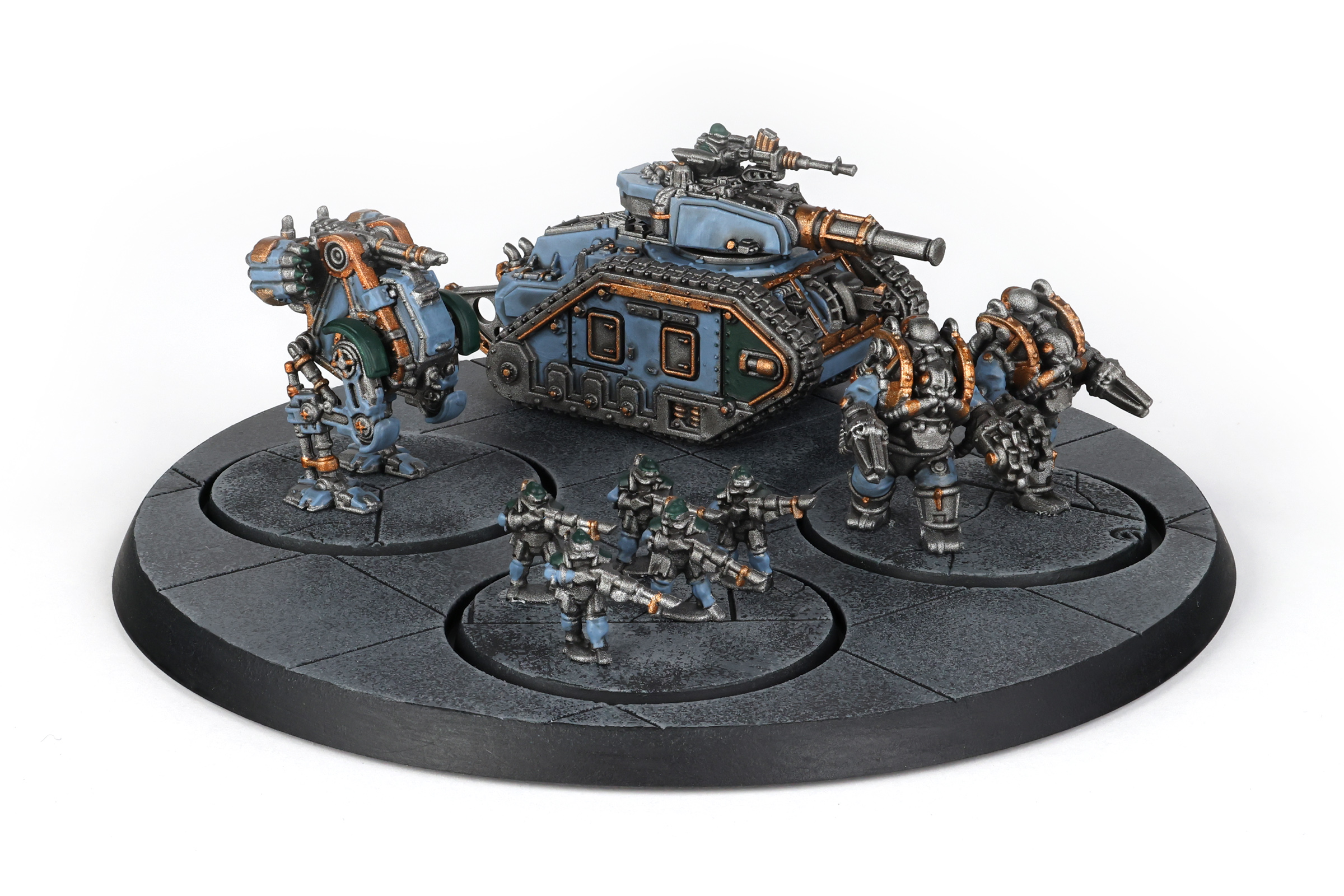
If what you’re looking for is some tiny tanks and a handful of adorable mini-dreadnoughts to make “pew pew” noises with, then this is a great way to get your hands on that. And there’s nowhere better to turn if you want to recreate the truly epic (pun intended, sadly) scenes from the Horus Heresy novels that the game’s 28mm-scaled cousin just cannot deliver. But if you’ve gotten this far into this review, you’re probably not certain if this game is for you. And if that’s the case, we recommend trying out the game before you invest, especially at this price point.
As always, if you have any questions or suggestions, drop us a line at Contact@Goonhammer.com.
